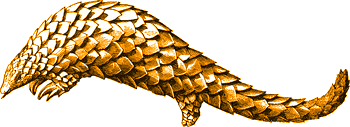Pholidota
Pangolins
 |
Only seven living species of mammal are included in the Pholidota, the pangolins or scaly anteaters. There are four species in Africa and three in southeast Asia. Pangolins were once more widely distributed throughout the world; an essentially modern-looking fossil pangolin, Eomanis, has been found in the Eocene of Germany, and another fossil pangolin has been found in the lower Oligocene of North America. Today, because of habitat destruction and hunting (pangolin scales are used in Chinese and African medicine), the three Asian species and one of the African species of pangolin are considered endangered.
Pangolins feed only on burrowing social insects, such as ants and termites. Some are arboreal, living in trees; others live in burrows. Pangolins have stout, strong, clawed limbs, used for digging into ant and termite mounds. The tongue of a pangolin can be extended about 25 cm, and has muscular roots that attach to the animal's pelvis! Pangolins completely lack teeth, and the lower jaw is a small bladelike bone. Perhaps the most obvious feature of pangolins is their scaly epidermal armor, making them look a bit like pine cones with legs. Confronted with a threat, pangolins curl very tightly into balls.
Pangolins resemble armadillos and anteaters, which also feed on insects and have long tongues, strong digging limbs, and reduced or missing teeth. Their resemblance to armadillos is even more striking; both are armored and curl up in response to danger. Yet pangolins lack certain highly distinctive skeletal features seen in armadillos and anteaters. Once pangolins were grouped with armadillos and anteaters in the Edentata, but today the similarities between pangolins and these others are considered to result from convergent evolution. Pangolins are no longer considered close relatives of the armadillos and anteaters, which are now grouped with the sloths in a separate order, the Xenarthra.
Source:
- Nowak, R.M. 1991. Walker's Mammals of the World. Volume 11. Johns Hopkins University Press, Baltimore.
